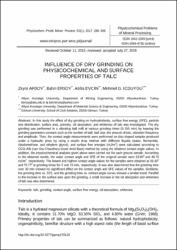Influence of dry grinding on physicochemical and surface properties of talc
Özet
In this study the effect of dry grinding on hydrophobicity, surface free energy (SFE), particle size distribution, surface area, porosity, oil absorption, and whiteness of talc was investigated. The dry grinding was performed in a vibrating ball mill at various grinding times (5-150 min) by keeping the grinding parameters constant such as the number of ball, ball size, the amount of talc, vibration frequency and amplitude. Then, the contact angle measurements were performed on disc-shaped samples produced under a hydraulic press by using a sessile drop method with different liquids (water, formamide, diiodomethane, and ethylene glycol), and surface free energies (mJ/m 2 ) were calculated according to OCG-AB (van Oss-Chaudhury-Good Acid-Base) method by using the obtained contact angle values. In addition, the physicochemical analyses given above were carried out for each ground sample. According to the obtained results, the water contact angle and SFE of the original sample were 63.80 and 48.70 mJ/m 2 , respectively. The lowest and highest contact angle values for the samples were obtained as 59.30 and 70.77 0 at grinding times for 5 and 15 min, respectively. It was also determined that the grinding time over 30 min showed no significant effect on the contact angle and SFE values of the samples. Similarly, the grinding time vs. SFE, and the grinding time vs. contact angle curves showed a similar trend. Parallel to the increase in the surface area upon the grinding, a small increase in the oil absorption and whiteness of talc was also determined.
Kaynak
Physicochemical Problems of Mineral ProcessingCilt
53Sayı
1Koleksiyonlar
- Makaleler [36]
- Scopus İndeksli Yayınlar Koleksiyonu [148]



















